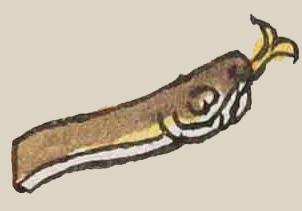coatl (Mdz24r)
This element for a snake or serpent (coatl) has been carved from the compound sign for the place name, Coacalco. This serpent is shown in a half-body, largely horizontal, with its head in profile and facing to the viewer's right. The body is brown facing to yellow, but its belly is white. A yellow, bifurcated tongue protrudes from its mouth.
Stephanie Wood
The appearance of the serpent's tongue recalls the glyph for (tletl) (fire or flame) (see below, right), although this one is only yellow, and the usual flame is red and yellow. Perhaps the snake's bite caused awe, much as fire did. Serpents did have an association with fire and the fire divinity, Xiuhtecuhtli, as explained by Esther Pasztory (paraphrased by Ian Mursell). The presence of rattles is also important, even if artists often omitted them, because rattlesnakes ware significant in Mesoamerican cultures, as the study of rattlesnakes by Ian Mursell of Mexicolore also elaborates. A wooden, turquoise-mosaic pectoral in the shape of a snake is held in the British Museum, whose curators have written: "The Mexica considered serpents to be powerful, multifaceted creatures that could bridge the spheres (the underworld, water and sky) owing to their physical and mythical characteristics." Besides being an animal that was common in the central highlands, the coatl is the name of the first day of a thirteen-day calendrical cycle.
Stephanie Wood
c. 1541, but by 1553 at the latest
Stephanie Wood
culebras, serpientes, víboras, cohuatl, crótalos

coa(tl), snake or serpent, https://nahuatl.wired-humanities.org/content/coatl
serpent or snake
el serpiente
Stephanie Wood
Codex Mendoza, folio 24 recto, https://digital.bodleian.ox.ac.uk/objects/2fea788e-2aa2-4f08-b6d9-648c00..., image 58 of 188.
The Bodleian Libraries, University of Oxford, hold the original manuscript, the MS. Arch. Selden. A. 1. This image is published here under the UK Creative Commons, “Attribution-NonCommercial-ShareAlike 3.0 License” (CC-BY-NC-SA 3.0).

